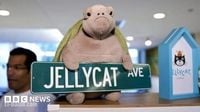Jellycat, the London-based soft toy company renowned for its whimsical plush creations, has just posted a financial performance that’s sending ripples through the global toy industry. According to recent filings with Companies House, Jellycat’s revenue soared by a staggering 66%, reaching £333 million for the fiscal year ending December 31, 2024. For a company that started with a simple mission, these numbers represent not just business success, but a cultural phenomenon in the making.
The company’s profits have doubled, and in a move that’s sure to delight its owners, Jellycat is rewarding shareholders with a record £110 million in dividends. That’s a 75% jump from last year’s payout of £63 million—a windfall that reflects the brand’s surging popularity and robust financial health. As reported by el-Balad, this is more than just a payout; it’s a testament to how a soft toy brand has captured the hearts (and wallets) of consumers around the world.
What’s behind this meteoric growth? The answer lies in a blend of nostalgia, innovation, and some very savvy use of social media. While Jellycat’s plush animals have long been a staple in nurseries, a new wave of adult collectors has emerged. These grown-up enthusiasts aren’t shy about sharing their love for the brand—Instagram and TikTok are brimming with creative photos and videos featuring Jellycat toys. According to both BBC and el-Balad, this adult-driven trend has become a powerful force, fueling brand visibility and turning Jellycat into a household name far beyond its original audience.
Jellycat’s leadership has been quick to recognize and nurture this shift. Founder and chairman Thomas Gatacre summed up the company’s ethos succinctly: “Our mission is simple: to create joy and try to be the most loved soft toy company in the world.” It’s a philosophy that resonates with fans of all ages, and one that’s clearly paying off.
But Jellycat’s success isn’t just about tapping into nostalgia or riding a social media wave. The brand has also pushed the envelope with its inventive pop-up experiences in major cities. In London, shoppers at Selfridges can step into a fish and chips-themed Jellycat zone, where staff curate playful, hands-on encounters with the toys. Over in New York, a Jellycat diner mixes food-themed plushies with a dose of retail therapy, while in Paris, adults flock to a Jellycat patisserie to browse soft animals reimagined as French pastries. These pop-up events have become magnets for fans, with videos of the experiences going viral and attracting millions of online views.
The creativity and energy behind these events have been instrumental in driving both sales and brand loyalty. Fans actively document and share their visits, weaving Jellycat into the fabric of contemporary culture. As el-Balad noted, these immersive experiences have turned the brand’s events into online spectacles, amplifying Jellycat’s reach and reputation.
Behind the scenes, Jellycat’s team has faced the not-so-small challenge of meeting skyrocketing demand across more than 80 countries. Operational efficiency has been key, and Gatacre has repeatedly emphasized the company’s commitment to quality and responsibility. “Every toy is delivered in excellent condition, built to last, and produced responsibly,” he stated. This attention to detail, along with a nimble approach to supply chain management, has allowed Jellycat to scale up rapidly without compromising its signature softness and quirky charm.
So, what is it about Jellycat that keeps fans coming back for more? For many, these plush toys are more than just playthings. They’re tokens of comfort, self-care, and emotional expression—especially for adults seeking a little joy in a fast-paced world. The company’s blend of innovative retail, strategic social media engagement, and a genuine focus on delighting customers has set a new benchmark in the toy industry. According to BBC, Jellycat’s rise is a testament to the enduring appeal of play and creativity, even in a digital age.
Jellycat’s global footprint continues to expand, with the brand now operating in over 80 countries. This international reach has brought both opportunity and responsibility. The company’s next steps will likely center on sustaining its impressive growth while deepening the emotional connection at the core of its brand. For shareholders, the £110 million dividend is a moment of celebration—a clear signal that Jellycat’s strategy is working. For fans, it’s another chapter in the story of a brand that has managed to turn simple joy into a business phenomenon.
There’s no denying that the toy market has changed dramatically in recent years. Where once toys were seen as the exclusive domain of children, today’s consumers are rewriting the rules. Adult collectors, fueled by nostalgia and a desire for comfort, have become a driving force. Social media platforms like Instagram and TikTok have given these fans a global stage, turning Jellycat toys into cultural touchstones and viral sensations. The result? A brand that’s as much about community and connection as it is about cuddly animals.
Jellycat’s ability to adapt and innovate has been central to its success. The company’s pop-up events are a case in point, offering fans an immersive, hands-on experience that goes far beyond traditional retail. Whether it’s a fish and chips-themed zone in London, a diner in New York, or a patisserie in Paris, these creative endeavors have captured the imagination of fans worldwide. As videos of these events continue to rack up millions of views, Jellycat’s reputation as a trendsetter in the toy industry only grows stronger.
Looking ahead, Jellycat faces both challenges and opportunities. The company’s leadership remains committed to quality, responsibility, and operational excellence—values that have served it well so far. As demand continues to rise, maintaining these standards will be crucial. But if the past year is any indication, Jellycat is more than up to the task.
For now, the company’s record profits and generous dividends are cause for celebration. But perhaps the real story is how Jellycat has managed to turn simple, soft toys into symbols of joy and connection for people of all ages. In a world that often feels anything but soft, that’s no small feat.




